Kerala Plus One Zoology Improvement Question Paper Say 2017 with Answers
| Board | SCERT |
| Class | Plus One |
| Subject | Zoology |
| Category | Plus One Previous Year Question Papers |
Time: 1 Hour
Cool off time: 10 Minutes
Maximum: 30 Scores
General Instructions to candidates:
- There is a ‘cool off time’ of 10 minutes each for Botany and Zoology in addition to the writing time of 1 hour each. Further there is a ‘5 minutes’ ‘preparatory time’ at the end of the Botany Examination and before the commencement of the Zoology Examination.
- Use the ‘cool off time’ to get familiar with the questions and to plan your answers.
- Read the instructions carefully.
- Read questions carefully before you answering.
- Calculations, figures and graphs should be shown in the answer sheet itself.
- Malayalam version of the questions is also provided.
- Give equations wherever necessary.
- Electronic devices except non-programmable calculators are not allowed in the Examination Hall.
I. Qn. No. 1 to 3. Answer all questions. Each question carries 1 score. (3 × 1 = 3)
Question 1.
Find out the pseudocoelomate animal from the following:
Tapeworm, Hookworm, Earthworm, Honeybee.
Answer:
Hookworm
Question 2.
Identify the word pair relation and fill the blanks:
a) Fish : ammonotelic :: Cockroach :……….
b) Bone : Osteocytes :: Cartilage:………..
Answer:
a) Urecotelic
b) Chondrocytes
Question 3.
ICZN stands for
a) International Council of Zoological Nomenclature
b) Indian Council fo Zoological Nomenclature
c) International Code of Zoological Nomenclautre
d) Indian Code of Zoological Nomenclature
Answer:
c) International Code of Zoological Nomenclature
II. Answer any nine questions from Qn. No. 4 to 14. Each question carries 2 scores. (9 × 2 = 18)
Question 4.
Certain disorders and their causes are given. Match them suitably.
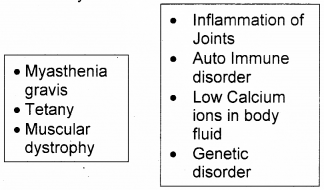
Answer:
Myasthenia gravis – Auto Imrnrme disorder
Tetany – Low Calcium ions in body fluid
Muscular dystrophy – Genetic disorder
Question 5.
“In the tissues, the conditions are favourable for dissociation of oxygen form the oxyhaemoglobin”. Write any four favourable conditions in the tissues for the dissociation of O2 from oxyhaemoglobin.
Answer:
In the tissues, low pO2 high pCO2, high H+ concentration and higher temperature exist are favourable for dissociation of oxygen from oxyhaemoglobin.
Question 6.
a) Classify the given organisms under the heading poikilothermous and homoiothermous
Rat, Frog, Dog fish, Ostrich
b) Define the terms poikilothermous and homoiothermous.
Answer:
a) Poikelotherms – Frog, Dog fish
Homeotherms – rats, ostrich
b) Poikelotherms-organism cannot maintain their internal environment as constant Homeotherms – organism can maintain their internal environment as constant
Question 7.
Classify the given hormones in the table.
Prolactin, Oxytocin, Leutinising hormone, Vasopressin.
| Released from Adenohypophysis | Released from neurohypophysis |
| – – | – – |
Answer:
Released from
adenohypophYsis ——— prolactin, luteinising hormone
Released from
Neurohypophysis ———- oxytocin, vasopressin
Question 8.
a) Identify the organism.
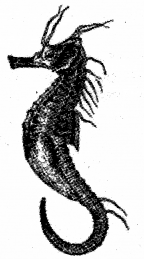
b) Name the class in which it belongs to?
c) Write any one characteristics feature of the class.
Answer:
a) Hippocampus
b) Osteichthyes
c) Skin is covered with cycloid/ctenoid scales
Question 9.
Fill in the blanks suitably.
In a protein, amino acids are linked by (a) ……… bond.
In a polysaccharide the individual monosaccharides are linked by (b) ……. bond.
Answer:
a) Peptide bond
b) Glycosidic bond
Question 10.
In (A) ……… type synapse the membranes of presynaptic and post synaptic neurons are in very close proximity.
In (B) ………. type synapse the membranes of pre and post synaptic neurons are separated by a fluid filled space.
a) Name the types of synapse A and B.
b) Name the fluid filled space in the synapse B.
Answer:
a) A) Electrical synapse
B) Chemical synapse
b) Neurotransmitter (acetyl choline)
Question 11.
Certain indicators regarding the layers in the wall of alimentary canal are given. Name the layers against the indicator.
a) Formed of loose connective tissues containing nerves and blood vessels.
b) Innermost lining forms rugae in the stomach.
c) Formed by smooth muscles.
d) Outermost layer made of mesothelium.
Answer:
a) Submucosal layer
b) Mucosa
c) Muscuiaris
d) Serosa
Question 12.
“The functioning of the kidneys is efficiently monitored and regulated by the heart to a certain extent”.
Do you agree with this statement? Justify your answer.
Answer:
Yes.
An increase in blood flow to the altria of the heart can cause the release of Atrial Natriuretic Factor (ANF), ANF can cause vasodilation (dilation of blood vessels) and thereby decrease the blood pressure. ANF mechanism acts as a check on the renin-angiotensin mechanism.
Question 13.
Flow does the increased level of Ca++ in the sarcoplasm help in muscle contraction?
Answer:
- Increase in Ca++ level leads to the binding of calcium with a subunit of troponin on actin filaments and thereby remove the masking of active sites for myosin.
- This pulls the attached actin filaments towards the centre of ‘A’ band. The ‘Z’ line attached to these actins are also pulled inwards thereby causing a shortening of the sarcomere, i.e., contraction.
Question 14.
a) Write the significance of reabsorption in urine formation.
b) Of the following substances which one is reabsorbed by active transport?
Glucose, Nitrogenous waste, Water.
Answer:
a) During reabsorption, nearly 99 per cent of the filtrate is reabsorbed by the renal tubules.
b) Glucose in the filtrate is reabsorbed actively.
III. Answer any three from Qn. No. 15 to 18. Each carries 3 scores. (3 × 3 = 9)
Question 15.
a) Effect of change in concentration of substrate on enzyme activity is graphically represented. After reaching a maximum velocity (Vmax), the reaction is not exceeded by any further rise in concentration of substrate. Explain.
b) Mention any 2 other factors that affect enzyme activity.
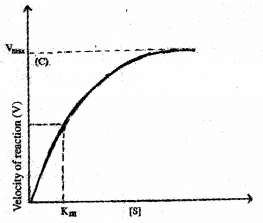
Answer:
a) Because the enzyme molecules are saturated there are no free enzyme molecules to bind with the additional substrate molecules.
b) Temperature and PH
Question 16.
Identify the figures A and B. Write any one characteristic feature of each A and B.
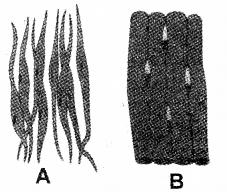
Answer:
A) These fibres taper at both ends (fusiform) and do not show striations.
B) These are striated (striped) skeletal muscle fibres bundled together in a parallel fashion.
Question 17.
Fill the blanks suitably.

Answer:
a) Granulocytes
b) basophils
c) monocytes
d) lymphocytes
e) allergic reactions
f) immune responses
Question 18.
Redraw the diagram. Name and label the parts indicated below.
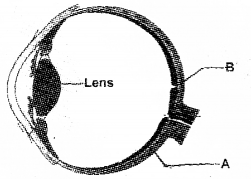
A – External layer of the eyeball.
B – Part where cones are densely packed.
Answer:

